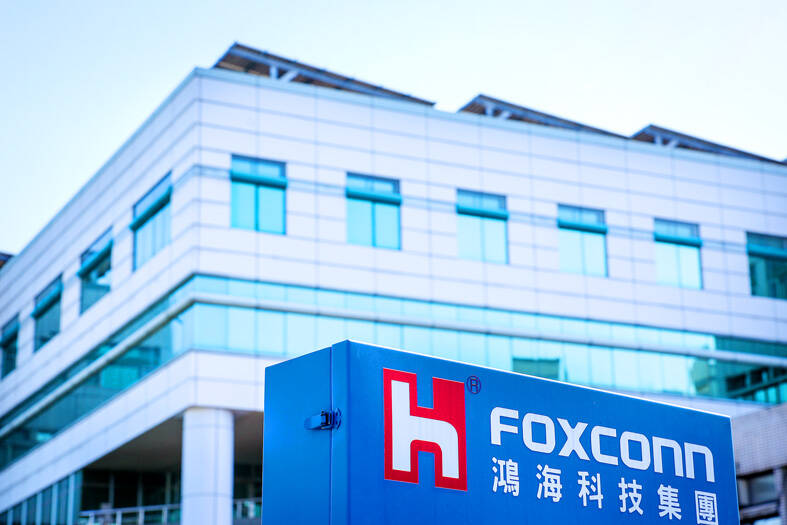Hon Hai Precision Industry Co (鴻海精密) yesterday said that its research institute has launched its first advanced artificial intelligence (AI) large language model (LLM) using traditional Chinese, with technology assistance from Nvidia Corp.
Hon Hai, also known as Foxconn Technology Group (富士康科技集團), said the LLM, FoxBrain, is expected to improve its data analysis capabilities for smart manufacturing, and electric vehicle and smart city development.
An LLM is a type of AI trained on vast amounts of text data and uses deep learning techniques, particularly neural networks, to process and generate language. They are essential for building and improving AI-powered servers.

Photo: CNA
Nvidia provided assistance and consultation through its “Taipei-1” supercomputer, allowing the Hon Hai Research Institute to use the Nvidia NeMo AI service platform to complete the training of the FoxBrain LLM, Hon Hai said.
During the training of FoxBrain, the researchers used 120 Nvidia H100 graphics processing units (GPUs) and Nvidia Quantum-2 InfiniBand, the seventh-generation InfiniBand. The technology provided AI developers and researchers with the fastest performance available, Hon Hai said.
The training was completed in just four weeks at low cost and high efficiency, it said.
The FoxBrain model demonstrates strong comprehension and reasoning abilities, performs well in mathematics and logical reasoning tests, and is optimized to produce text that feels more natural and relevant to Taiwanese users, it said.
The model covers a wide range of areas, such as data analysis, decisionmaking aid, writing assistance, mathematics, code generation and problem-solving through its inferential capability, it added.
FoxBrain is expected to be made open-source, providing AI computing codes to other enterprises and researchers, enabling them to use LLM technologies to enhance and promote their own products, Hon Hai said.
FoxBrain has made significant progress in math tests compared with the Chinese-language model Taiwan Llama. It also outperforms Meta Platforms Inc’s current models of the same level in mathematical reasoning, the company said.
While FoxBrain is still a little behind DeepSeek’s (深度求索) models, its performance is already close to the best in the world, Hon Hai said.
FoxBrain is expected to drive the growth of smart devices and enhance AI-driven applications in manufacturing, supply chain management and intelligent decisionmaking, the company said.
Hon Hai is set to showcase FoxBrain at Nvidia’s GPU Technology Conference in San Jose, California, on Monday. The company would present its achievements in a keynote speech titled “From open source to frontier AI: Build, customize and extend foundation models,” it said.

SELL-OFF: Investors expect tariff-driven volatility as the local boarse reopens today, while analysts say government support and solid fundamentals would steady sentiment Local investors are bracing for a sharp market downturn today as the nation’s financial markets resume trading following a two-day closure for national holidays before the weekend, with sentiment rattled by US President Donald Trump’s sweeping tariff announcement. Trump’s unveiling of new “reciprocal tariffs” on Wednesday triggered a sell-off in global markets, with the FTSE Taiwan Index Futures — a benchmark for Taiwanese equities traded in Singapore — tumbling 9.2 percent over the past two sessions. Meanwhile, the American depositary receipts (ADRs) of Taiwan Semiconductor Manufacturing Co (TSMC, 台積電), the most heavily weighted stock on the TAIEX, plunged 13.8 percent in

A wave of stop-loss selling and panic selling hit Taiwan's stock market at its opening today, with the weighted index plunging 2,086 points — a drop of more than 9.7 percent — marking the largest intraday point and percentage loss on record. The index bottomed out at 19,212.02, while futures were locked limit-down, with more than 1,000 stocks hitting their daily drop limit. Three heavyweight stocks — Taiwan Semiconductor Manufacturing Co (TSMC, 台積電), Hon Hai Precision Industry Co (Foxconn, 鴻海精密) and MediaTek (聯發科) — hit their limit-down prices as soon as the market opened, falling to NT$848 (US$25.54), NT$138.5 and NT$1,295 respectively. TSMC's

TARIFFS: The global ‘panic atmosphere remains strong,’ and foreign investors have continued to sell their holdings since the start of the year, the Ministry of Finance said The government yesterday authorized the activation of its NT$500 billion (US$15.15 billion) National Stabilization Fund (NSF) to prop up the local stock market after two days of sharp falls in reaction to US President Donald Trump’s new import tariffs. The Ministry of Finance said in a statement after the market close that the steering committee of the fund had been given the go-ahead to intervene in the market to bolster Taiwanese shares in a time of crisis. The fund has been authorized to use its assets “to carry out market stabilization tasks as appropriate to maintain the stability of Taiwan’s

STEEP DECLINE: Yesterday’s drop was the third-steepest in its history, the steepest being Monday’s drop in the wake of the tariff announcement on Wednesday last week Taiwanese stocks continued their heavy sell-off yesterday, as concerns over US tariffs and unwinding of leveraged bets weighed on the market. The benchmark TAIEX plunged 1,068.19 points, or 5.79 percent, to 17,391.76, notching the biggest drop among Asian peers as it hit a 15-month low. The decline came even after the government on late Tuesday authorized the NT$500 billion (US$15.2 billion) National Stabilization Fund (國安基金) to step in to buoy the market amid investors’ worries over tariffs imposed by US President Donald Trump. Yesterday’s decline was the third-steepest in its history, trailing only the declines of 2,065.87 points on Monday and